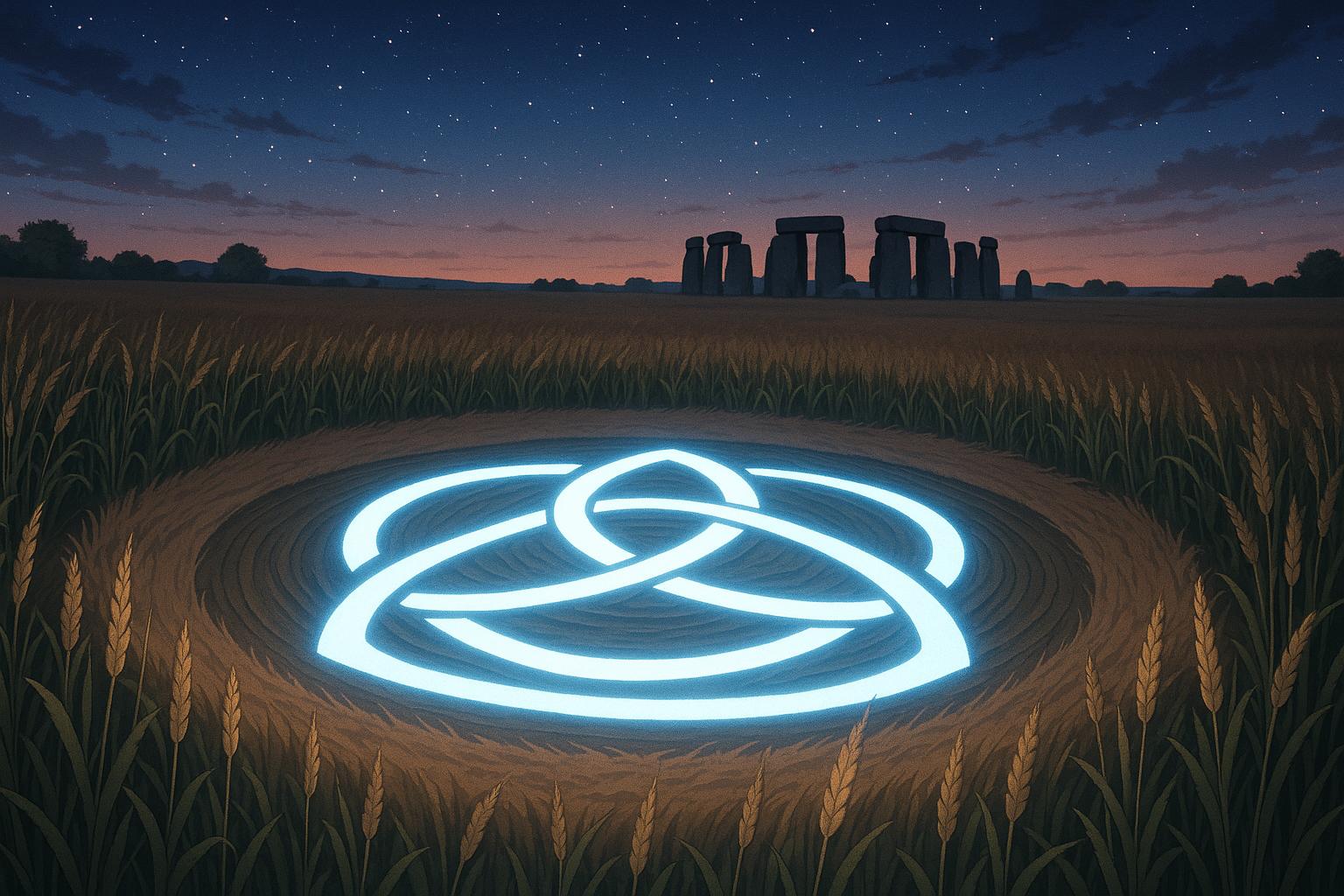Mysterious crop circles have once again captured the imagination of enthusiasts and sceptics alike, particularly as new formations were discovered in Wiltshire, a region renowned as a hotspot for this enigmatic phenomenon. Situated just 13 miles from Stonehenge, Wiltshire has been at the heart of crop circle activity since the 1970s, with recent sightings rekindling interest and speculation about their origins.
On May 15, 2025, a beautifully crafted geometric design was found in a farmer’s field in the village of Sutton Veny. The formation featured a central motif resembling a Celtic knot or a four-pointed star within a circle, creating a striking visual that draws both admiration and intrigue. Only days later, on May 19, another unique formation was noted in a Dorset field, approximately 30 miles away. This design consisted of a series of geometric shapes encased by two overlapping circles, further adding to the growing body of evidence that these formations continue to emerge.
While many suggest that crop circles are mere artworks or pranks orchestrated by creative individuals, UFO conspiracy theorists cling to the belief that they are messages from extraterrestrial beings. Some formations can range from 50 to 1,000 feet in length and reportedly take mere minutes to create, leading to speculation about their otherworldly origins. Although crop circles have been documented in countries across the globe, including the United States and Japan, approximately 80% of them are reported in the UK. Since 2005, the Wiltshire region alone has recorded over 380 occurrences, making it the most densely populated area for these intriguing patterns. The peak season for sightings typically falls between May and August, aligning with the maturation of crops suitable for such visible displays.
Despite the allure these circles hold, local farmers often view them with dismay. The owner of the Sutton Veny field expressed significant upset over the flattening of his valuable crops, although he has chosen to adapt by allowing crop circle enthusiasts entry to his field for a small fee to view the creation. This duality of delight and distress echoes the broader impact that crop circles have on local agriculture and the economy, particularly in communities accustomed to the influx of curious visitors and researchers.
Spanning back decades, the mystery of crop circles has been fuelled by various theories attributing their creation to everything from earth energies and gravitational forces to the influence of ley lines, which are often linked to spiritual or mystical sites like Stonehenge. Monique Klinkenbergh, founder of the crop circle exhibition in Wiltshire’s Pewsey Vale, acknowledges that while some formations are undoubtedly man-made, certain designs remain enigmatic. “If you listen to eyewitness accounts, the unexplained circles have one thing in common—they were formed in minutes, or seconds, by an invisible source,” she articulated in a recent BBC interview. This sentiment reflects a growing body of anecdotal evidence that suggests a deeper mystery surrounding these formations.
One notable example is the Milk Hill circle from 2001, a formation nearly 800 feet wide boasting over 400 circles. Described as too complex for human creation in a single night, it remains a pivotal point of discussion for UFO researchers who believe such intricacies hint at alien intervention. Indeed, accounts of witnesses who claim to have observed luminous orbs hovering above fields just prior to the appearance of these formations add an element of the supernatural to the investigation.
Despite the fervent debate surrounding their origins, several individuals have confessed to creating crop circles, including Doug Bower and Dave Chorley, who, in 1991, acknowledged crafting over 200 formations using simple tools during the 1970s. Similarly, a team of aerospace students from MIT demonstrated how they could produce formations that could easily be mistaken for authentic alien messages, further complicating the narrative of genuine versus fabricated designs.
As new crop circles continue to emerge, spawning a mix of intrigue, tourism, and disputes over agricultural damage, the discussion surrounding their origins remains an active one. Enthusiasts hope to unlock the mysteries hidden within these formations, while sceptics argue that the true source may be a mix of art, prank, and perhaps an unsuspected natural phenomenon. Regardless of where one stands in this debate, the continued fascination with crop circles is a testament to humanity’s enduring quest for understanding the unknown.
Reference Map
- Paragraphs 1, 2, 3, 4, 7
- Paragraph 3
- Paragraph 4
- Paragraph 4
- Paragraph 4
- Paragraph 6
- Paragraph 6
Source: Noah Wire Services
